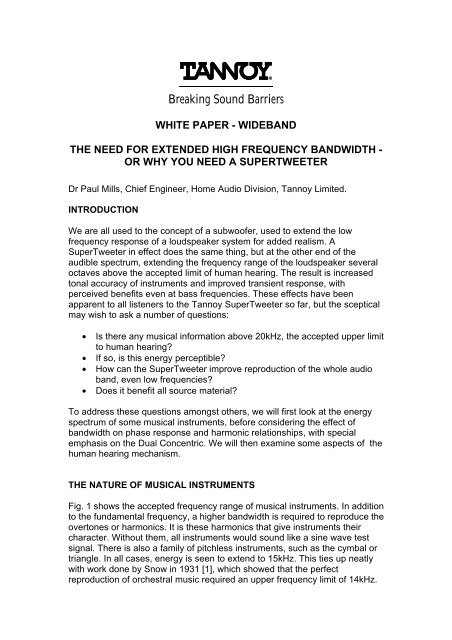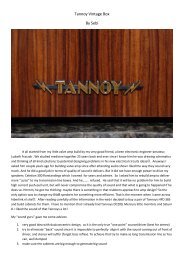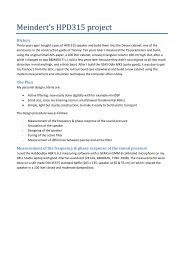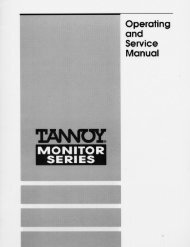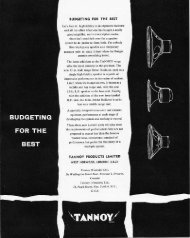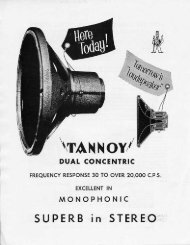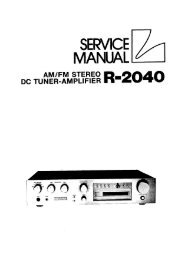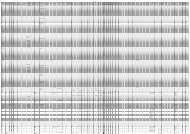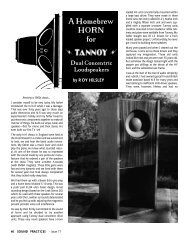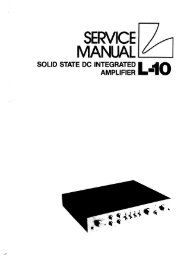Tannoy supertweeter paper in pdf format
Tannoy supertweeter paper in pdf format
Tannoy supertweeter paper in pdf format
You also want an ePaper? Increase the reach of your titles
YUMPU automatically turns print PDFs into web optimized ePapers that Google loves.
B<br />
Break<strong>in</strong>g Sound Barriers<br />
WHITE PAPER - WIDEBAND<br />
THE NEED FOR EXTENDED HIGH FREQUENCY BANDWIDTH -<br />
OR WHY YOU NEED A SUPERTWEETER<br />
Dr Paul Mills, Chief Eng<strong>in</strong>eer, Home Audio Division, <strong>Tannoy</strong> Limited.<br />
INTRODUCTION<br />
We are all used to the concept of a subwoofer, used to extend the low<br />
frequency response of a loudspeaker system for added realism. A<br />
SuperTweeter <strong>in</strong> effect does the same th<strong>in</strong>g, but at the other end of the<br />
audible spectrum, extend<strong>in</strong>g the frequency range of the loudspeaker several<br />
octaves above the accepted limit of human hear<strong>in</strong>g. The result is <strong>in</strong>creased<br />
tonal accuracy of <strong>in</strong>struments and improved transient response, with<br />
perceived benefits even at bass frequencies. These effects have been<br />
apparent to all listeners to the <strong>Tannoy</strong> SuperTweeter so far, but the sceptical<br />
may wish to ask a number of questions:<br />
• Is there any musical <strong>in</strong><strong>format</strong>ion above 20kHz, the accepted upper limit<br />
to human hear<strong>in</strong>g?<br />
• If so, is this energy perceptible?<br />
• How can the SuperTweeter improve reproduction of the whole audio<br />
band, even low frequencies?<br />
• Does it benefit all source material?<br />
To address these questions amongst others, we will first look at the energy<br />
spectrum of some musical <strong>in</strong>struments, before consider<strong>in</strong>g the effect of<br />
bandwidth on phase response and harmonic relationships, with special<br />
emphasis on the Dual Concentric. We will then exam<strong>in</strong>e some aspects of the<br />
human hear<strong>in</strong>g mechanism.<br />
THE NATURE OF MUSICAL INSTRUMENTS<br />
Fig. 1 shows the accepted frequency range of musical <strong>in</strong>struments. In addition<br />
to the fundamental frequency, a higher bandwidth is required to reproduce the<br />
overtones or harmonics. It is these harmonics that give <strong>in</strong>struments their<br />
character. Without them, all <strong>in</strong>struments would sound like a s<strong>in</strong>e wave test<br />
signal. There is also a family of pitchless <strong>in</strong>struments, such as the cymbal or<br />
triangle. In all cases, energy is seen to extend to 15kHz. This ties up neatly<br />
with work done by Snow <strong>in</strong> 1931 [1], which showed that the perfect<br />
reproduction of orchestral music required an upper frequency limit of 14kHz.
Fig. 1 The Frequency Range of Musical Instruments<br />
That was accepted wisdom then, and identical <strong>in</strong><strong>format</strong>ion is still be<strong>in</strong>g<br />
reproduced <strong>in</strong> many modern text books. A quick measurement with a<br />
spectrum analyser shows that this is clearly not the case, but few researchers<br />
have considered the true bandwidth of musical <strong>in</strong>struments or <strong>in</strong>vestigated the<br />
<strong>in</strong> depth mechanism of human hear<strong>in</strong>g at high frequencies.<br />
The most thorough <strong>in</strong>vestigation <strong>in</strong>to spectra we cite is that of Boyk [2], and<br />
we reproduce some of his figures with permission. Fig. 2 shows the spectral<br />
content of a trumpet, with a particular type of mute. There is considerable<br />
energy above 20kHz, as can be seen, the level of which does not drop <strong>in</strong>to<br />
the noise floor until 100kHz. A similar result is found with <strong>in</strong>struments from the<br />
other musical families, with the viol<strong>in</strong> and oboe show<strong>in</strong>g energy above 40kHz.<br />
Even sibilants <strong>in</strong> speech were found to have energy above 40kHz.<br />
It is the pitchless <strong>in</strong>struments, such as members of the percussion family that<br />
generate the greatest amount of ultrasound. The cymbal crash (Fig. 3) gave<br />
40% of its energy above 20kHz, while the triangle was found to have a<br />
healthy output at 100kHz (Fig. 4).
Fig. 2 Spectral Energy from Trumpet<br />
Fig. 3 Spectral Energy from Cymbals
Fig. 4 Spectral Energy from Triangle<br />
ABOUT HARMONICS, PHASE & THE DUAL CONCENTRIC<br />
Over the frequency range that a Dual Concentric operates, it does a far better<br />
job of preserv<strong>in</strong>g the harmonic content of <strong>in</strong>struments compared with a<br />
conventional discrete drive unit arrangement. This is because the low and<br />
high frequency sounds are generated from the same po<strong>in</strong>t <strong>in</strong> space (po<strong>in</strong>t<br />
source), and there are no time and phase differences between harmonics<br />
below and above the crossover po<strong>in</strong>t, as with discrete speakers.<br />
Also the relationship <strong>in</strong> amplitude of fundamental and harmonics is accurately<br />
preserved both on axis and at po<strong>in</strong>ts off axis. In a normal room, the majority of<br />
sounds perceived by the human ear are reflections generated by the off axis<br />
response of the speaker. The even off axis response of the Dual Concentric<br />
means that the reflected energy has the same harmonic structure as the<br />
direct on axis energy. This is illustrated <strong>in</strong> Fig. 5<br />
The other element of the Dual Concentric that is a function of its po<strong>in</strong>t source<br />
nature, is that it provides l<strong>in</strong>ear phase response. Every loudspeaker or audio<br />
device exhibits a low pass filter function [3], and consequently act as a<br />
frequency <strong>in</strong>dependent time delay <strong>in</strong> the pass band, otherwise known as a<br />
l<strong>in</strong>ear phase response. However, with discrete drive units that are not time<br />
aligned, severe phase errors occur <strong>in</strong> the pass band, while the Dual<br />
Concentric offers an almost ideal l<strong>in</strong>ear phase response (Fig. 6). This better<br />
preserves the harmonic relationship of <strong>in</strong>struments and improves the transient<br />
performance. Note though that the phase response does deviate from the<br />
ideal at very high and very low frequencies. This is a natural result of the high<br />
and low frequency roll off po<strong>in</strong>ts of the system. To reduce the low frequency<br />
phase error, we would add a subwoofer, which does more than just add bass.<br />
It is this reduction of phase error we believe is one of the ma<strong>in</strong> benefits of a<br />
well <strong>in</strong>tegrated subwoofer. Music with no apparent bass content will sound<br />
more natural when this error is removed.
Fig. 5 How the Dual Concentric Preserves Harmonic Relationships
Fig. 6 Dual Concentric Phase Error Compared to a Discrete System<br />
Likewise, the addition of a SuperTweeter, time aligned to the acoustic centre<br />
of the Dual Concentric, will reduce the high frequency phase error by mov<strong>in</strong>g<br />
the low pass roll off po<strong>in</strong>t much higher, typically –6dB @ 54kHz, -18dB @<br />
100kHz. So even if we ignore for now the perception of sound above 20kHz,<br />
the addition of a SuperTweeter will better preserve the harmonic relationship<br />
between <strong>in</strong>struments. To illustrate this, Fig. 7 shows the phase error with both<br />
a 20kHz roll off and a 54kHz roll off. There is clearly less phase error not just<br />
a high frequencies, but as low as 5kHz also.
Amplitude 54kHz<br />
Amplitude 54kHz<br />
Phase 54kHz<br />
Phase 20kHz<br />
Fig. 7 Addition of SuperTweeter Gives Less Phase Error<br />
HUMAN PERCEPTION OF ULTRASOUND<br />
So far we have considered how the addition of a SuperTweeter improves the<br />
phase and transient performance of a loudspeaker, especially a Dual<br />
Concentric, <strong>in</strong> what is traditionally known as the audible band up to 20kHz.<br />
We know that musical <strong>in</strong>struments have energy up to and beyond 100kHz, but<br />
can we perceive it?<br />
Japanese researchers Oohashi et al [5] conducted experiments with wide<br />
bandwidth material to 60kHz, whereby a SuperTweeter could be either<br />
switched <strong>in</strong> or out. By monitor<strong>in</strong>g the subjects’ bra<strong>in</strong>wave activity and not<strong>in</strong>g<br />
subjective scores under bl<strong>in</strong>d conditions, they concluded that the listeners<br />
were <strong>in</strong>deed respond<strong>in</strong>g to the ultrasonic components <strong>in</strong> the music.<br />
A further <strong>paper</strong> [6], concluded that profoundly deaf subjects relied on<br />
ultrasonic detection <strong>in</strong> their discrim<strong>in</strong>ation of speech and tones. They<br />
concluded the mechanism was through bone conduction, probably to a small<br />
organ <strong>in</strong> the <strong>in</strong>ner ear called the saccule, which is effectively wired to the<br />
cochlea, the organ responsible for hear<strong>in</strong>g as we know it.<br />
Dur<strong>in</strong>g development of the SuperTweeter, an <strong>in</strong>terest<strong>in</strong>g result was noted. We<br />
were try<strong>in</strong>g to cancel a 10dB peak <strong>in</strong> the response at 30kHz, electrically <strong>in</strong> the<br />
crossover network. For the measurements, we used a pseudo- random digital<br />
noise sequence, with 100kHz bandwidth. The presence or absence of this<br />
peak could readily be discrim<strong>in</strong>ated by listeners, even under bl<strong>in</strong>d conditions.<br />
There was however no change <strong>in</strong> the measured frequency response below<br />
28kHz, further support<strong>in</strong>g the above research.
CONCLUSIONS<br />
In this White Paper we have shown that musical <strong>in</strong>struments produce energy<br />
well above the generally considered limit of human hear<strong>in</strong>g. Research has<br />
shown that we are capable of respond<strong>in</strong>g to this energy, justify<strong>in</strong>g the addition<br />
of a SuperTweeter where wide bandwidth sources are used. Even with<br />
conventional CD sources, the addition of a SuperTweeter reduces phase error<br />
and improves transient performance significantly below 20kHz. This leads to<br />
<strong>in</strong>creased tonal accuracy at all frequencies, as the harmonics of <strong>in</strong>struments<br />
are not distorted <strong>in</strong> time. This benefits any high quality loudspeaker, but<br />
especially the Dual Concentric, with its superior time alignment <strong>in</strong> the first<br />
place. It should be stressed though, that even with the addition of a<br />
SuperTweeter, the Dual Concentric still acts effectively as a co<strong>in</strong>cident po<strong>in</strong>t<br />
source, as it is still responsible for generat<strong>in</strong>g the vast majority of musical<br />
<strong>in</strong><strong>format</strong>ion.<br />
We expect our source material and audio electronics to be of wide bandwidth<br />
and have excellent tonal and transient accuracy. There is now no reason for<br />
the loudspeaker to be considered the weak l<strong>in</strong>k <strong>in</strong> the cha<strong>in</strong> <strong>in</strong> this respect.<br />
ACKNOWLEDGEMENTS<br />
The Author is grateful to James Boyk, Pianist <strong>in</strong> Residence, The Music Lab.,<br />
California Institute of Technology, for his <strong>in</strong>terest and allow<strong>in</strong>g some of his<br />
measurements to be reproduced. Also to Ambrose Thompson of <strong>Tannoy</strong> for<br />
his valuable help.<br />
REFERENCES<br />
[1] W. B. Snow, Jour. Acous. Soc. Amer., Vol. 3, No. 1, Part 1 (1931).<br />
[2] J. Boyk, There’s Life Above 20kHz- A Survey of Musical Instrument<br />
Spectra to 102.4kHz, http://www.cco.caltech.edu/~boyk.<br />
[3] D. Jensen, High Frequency Phase Specifications- Useful or Mislead<strong>in</strong>g?<br />
JAES, Vol. 36, No. 12 (Dec. 1988).<br />
[4] W. Marshall Leach JR, The Differential Time Delay Distortion and<br />
Differential Phase-Shift Distortion as Measures of Phase L<strong>in</strong>earity, JAES, Vol.<br />
37, No. 9 (Sept. 1989).<br />
[5] T. Oohashi et al, High-Frequency Sound Above the Audible Range Affects<br />
Bra<strong>in</strong> Electric Activity, AES Prepr<strong>in</strong>t No. 3207 (91 st Convention, New York).<br />
[6] M. Lenhardt et al, Ultrasonic Speech Perception, Science, Vol. 253 (July<br />
1991).<br />
Dr. Paul Mills / <strong>Tannoy</strong> Market<strong>in</strong>g 14.12.99 14:45


